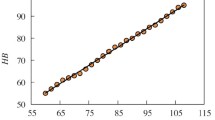Abstract—
In this paper, we studied the microstructure and mechanical properties of thin-sheet TRIP steel VNS9-Sh obtained by cold rolling of a hot rolled sheet for several transitions with intermediate heat treatment and supplied in the form of a strip with a thickness of 250–260 μm. The structure of the TRIP steel is deformation martensite and metastable hardened austenite. On the basis of the average grain size (35 μm) and the strip thickness, the optimum loading of the Vickers pyramid equal to 1 kgf (9.81 N) was determined when determining the hardness. Under this load, the indent covers several grains of steel and the ratio of the tape thickness to the indent depth is at least 20, which excludes the influence of the substrate (the instrument stage or other equipment) on the hardness values. To evaluate other mechanical properties, a kinetic (instrumental) indentation by a spherical diamond indenter with a radius of 0.2 mm was used. A methodolgy for determining the normal elastic modulus, yield stress, and time resistance is proposed. It is shown that the maximum deviation of the values of the indicated mechanical characteristics found by instrumented indentation from the values of these characteristics determined by the sample tension test did not exceed ±7%.



Similar content being viewed by others
REFERENCES
Filippov, M.A., Litvinov, V.S., and Nemirovskii, Yu.R., Stali s metastabil’nym austenitom (Steels with Non-Stable Austenite), Moscow: Metallurgiya, 1988.
Georgieva, I.Ya., Trip steels—a new class of high-strength steels with high plasticity, Met. Sci. Heat Treat., 1976, vol. 18, no. 3, pp. 209–218.
Voznesenskaya, N.M., Eliseev, E.A., Kapitanenko, D.V., and Tonysheva, O.A., Optimization of the technological conditions of producing thin sheets and strips from corrosion-resistant VNS9-Sh steel, Russ. Metall. (Engl. Transl.), 2014, vol. 2014, no. 1, pp. 39–43.
Terentyev, V.F. and Korableva, S.A., Ustalost’ metallov (Fatigue of Metals), Moscow: Nauka, 2015.
Terentyev, V.F., Slizov, A.K., Prosvirnin, D.V., et al., Fatigue resistance properties of the helicopters main rotor torsions bars before and after their operation, Deform. Razrushenie Mater., 2013, no. 5, pp. 18–24.
Terent’ev, V.F., Slizov, A.K., Prosvirnin, D.V., Sirotinkin, V.P., Ashmarin, A.A., Eliseev, E.A., and Rybal’chenko, O.V., Effect of the phase composition of the surface layer on the mechanical properties of 23Kh15N5AM3-Sh TRIP steel sheets, Russ. Metall. (Engl. Transl.), 2016, vol. 2016, no. 4, pp. 361–364.
Matyunin, V.M., Dragunov, V.K., and Marchenkov, A.Yu., A size effect in the indentation of materials at the micro- and nanoscale strained volumes, in Piezoelectrics and Nanomaterials: Fundamentals, Developments and Applications, Parinov, I.A., Ed., New York: Nova Science, 2015.
Chaudhri, M.M., Subsurface strain distribution around Vickers hardness indentations in annealed polycrystalline copper, Scr. Mater., 1998, vol. 46, no. 9, pp. 3047–3056.
Markovets, M.P., Opredelenie mekhanicheskikh svoistv metallov po tverdosti (Determination of Mechanical Properties of Metals Using the Hardness Values), Moscow: Mashinostroenie, 1979.
Chaudhri, M.M., Subsurface plastic strain distribution around spherical indentations in metals, Philos. Mag. A, 1996, vol. 74, no. 5, pp. 1213–1224.
Matyunin, V.M., Indentirovanie v diagnostike mekhanicheskikh svoistv materialov (Use the Indentation in Diagnostics of Mechanical Properties of Material), Moscow: Mosk. Energ. Inst., 2015.
Matlin, M.M., Operative control of module of normal elasticity, Vserossiiskaya nauchno-tekhnicheskaya konferentsiya “Fiziko-mekhanicheskie svoistva materialov i ikh ekspressnaya otsenka nerazrushayushchim metodom i portativnymi sredstvami,” Tezisy dokladov (All-Russ. Sci.-Tech. Conf. “Physical and Mechanical Properties of Materials and Their Express Nondestructive Testing and Using Portative Devices,” Abstracts of Papers), Volgograd: Volgograd. Gos. Tekh. Univ., 1995, pp. 27–29.
Oliver, W.C. and Pharr, G.M., Measurement of hardness and elastic modulus by instrumented indentation: advances in understanding and refinements to methodology. J. Mater. Res., 2004, vol. 19, no. 1, pp. 3–20
ACKNOWLEDGMENTS
This work was supported by the Russian Foundation for Basic Research, project no. 15-08-06761, and performed at the National Research University MPEI.
Author information
Authors and Affiliations
Corresponding author
Additional information
Translated by A. Ivanov
Rights and permissions
About this article
Cite this article
Matyunin, V.M., Terent’ev, V.F., Marchenkov, A.Y. et al. Determination of Hardness and Other Mechanical Properties of Thin-Sheet TRIP Steel by Indenting. Inorg Mater 54, 1556–1560 (2018). https://doi.org/10.1134/S0020168518150128
Received:
Published:
Issue Date:
DOI: https://doi.org/10.1134/S0020168518150128



